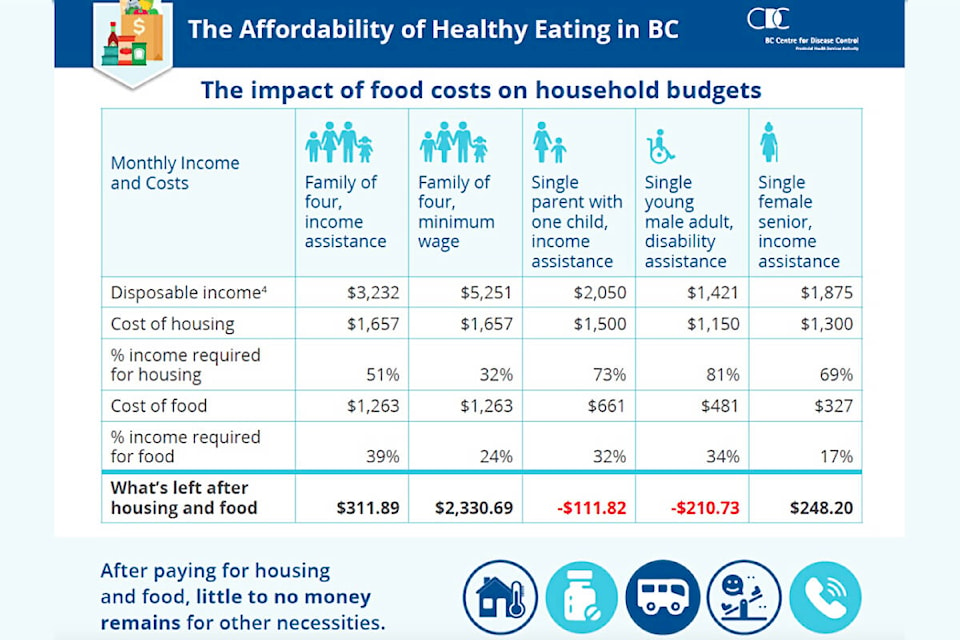A new report has highlighted the fact that for many middle- and low-income families in B.C., the cost of maintaining a nutritious diet is escalating beyond their financial means.
The Food Costing in BC 2022 report shines a light on the high cost of healthy eating and the health cost challenges posed by food insecurity, which is described as a “significant public health issue” by Dr. Geoff McKee, medical director of population and public health with the BC Centre for Disease Control (BCCDC).
“The price of food does not affect everyone equally and the root cause of household food insecurity is low incomes,” he says.
The BCCDC collaborates with the provincial Ministry of Health and regional health authorities to monitor the average cost of a nutritious diet in B.C. According to the report, the average monthly cost in 2022 for a nutritious diet for a family of four ranged from $1,193 to $1,366 across the five provincial health authorities.
The report also broke down the cost for different areas within each health authority. In Interior Health, the monthly food cost for a family of four (adult male and female each aged 31-50 years old, male child aged 14-18 years old, female child aged 4-8 years old) ranged from $1,205 in Thompson Cariboo Shuswap to $1,307 in East Kootenay.
The costs were determined using the National Nutritious Food Basket (NNFB), a tool used by various levels of government and other stakeholders to monitor the cost and affordability of healthy eating, and by surveying a randomly selected sample of 252 full-service grocery stores. So-called “high end health food” stores, which were identified as carrying a high proportion of organic, specialty, and local foods, were excluded.
The NNFB is made up of 61 ordinary food items (vegetables and fruits, protein foods, grains, and oils and fats) that are minimally processed, require preparation by consumers, and are considered by Health Canada to be commonly eaten by most people in Canada.
Household food insecurity ranges from worrying about running out of food (marginal food insecurity), to not being able to afford healthy food (moderate food insecurity), to missing meals, reducing intake, or going a day or more without eating (severe food insecurity). In 2021, 14.9 per cent of households in B.C., representing 732,000 people, experienced household food insecurity, with 4.4 per cent, 7.3 per cent, and 3.2 per cent experiencing marginal, moderate, and severe household food insecurity respectively. Approximately 145,000, or one in six, children in B.C. lived in a food insecure household in 2021.
The report states that disproportionately high rates of food insecurity are found among lower income households, families headed by single female parents, Indigenous people, individuals who identify as Black, people who are marginally housed or experiencing homelessness, people living with disabilities, new immigrants, and other systemically marginalized populations. While households whose main source of income is from social assistance have the highest rate of household food insecurity, the majority of households who experience household food insecurity work in paid employment and rely on income from wages, salaries, or self-employment.
Household food insecurity negatively affects people’s health and well-being, and it takes a toll on the health care system. People who experience household food insecurity are much more likely to experience chronic physical and mental health problems and suffer from infectious and non-communicable diseases. They are also more likely to experience negative disease outcomes, be hospitalized, and die prematurely.
Household food insecurity places a substantial burden on B.C.’s health care system and expenditures. One study found health care costs were 16 per cent higher for marginally food insecure and 76 per cent higher for severely food insecure households compared to food secure households. In 2018, the economic burden of not meeting healthy eating recommendations in Canada was estimated to be approximately $13.8 billion per year ($5.1 billion of which is associated directly with health care costs and $8.7 billion with indirect costs such as lost productivity).
“Household food insecurity takes a major toll on people’s physical and mental health, social and emotional well-being, and on our provincial health care system,” says Dr. Charmaine Enns, medical health officer for Island Health.
Those sentiments are echoed by Dr. Fatemah Sabet, medical health officer for Interior Health, who says all three levels of government – federal, provincial, and civic – need to collaborate on finding equity-based solutions.
“Food insecurity is a very complex problem and we need governments and food security organizations to work together to address the root causes behind it,” Sabet says. “This report shows the difficulty many people on lower incomes face after the subtraction of housing and food costs. There is not much left for families to live on,” she says.
The report highlights the health implications of food insecurity, which contributes to the increased likelihood of some birth defects, anemia, lower nutrient intake, asthma, poorer general health, and hospitalization among children.
Individuals in food insecure households report higher levels of poor or fair self-rated health, as well as diabetes, heart disease, high blood pressure, social isolation, depression, and sleep anxiety. Children in food insecure households may have poorer academic outcomes and social skills compared to children who do not experience food insecurity, while youth who experience hunger are more likely to have asthma or another chronic condition.
“Food insecurity has a lot of impacts on our physical, mental, and emotional well-being, problems that need to be addressed,” says Sabet. “This report highlights that and hopefully can generate some talking points for discussions going forward.”
editorial@accjournal.ca
Like us on Facebook and follow us on Twitter
